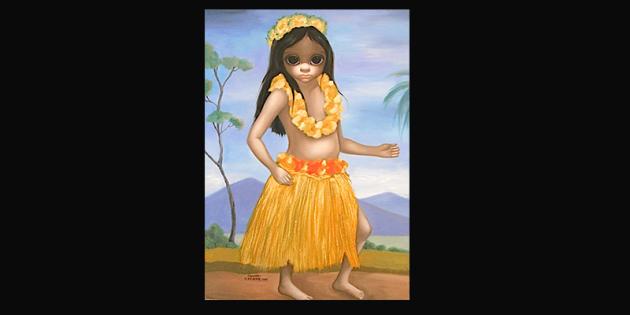The success of the Tim Burton film Big Eyes which tells the incredible story of American artist Margaret Keane, her scheming husband Walter Keane, and one of the greatest frauds of all time, has rekindled interest in her work, which has seen a resurgence in popularity and a Museum exhibition.
Margaret Keane’s melancholy portraits of big-eyed children became phenomenally successful in the 1950’s and 1960’s—fans and collectors included Natalie Wood, Andy Warhol, Joan Crawford, Dean Martin, Jerry Lewis, and even the United Nations itself. But Margaret received no recognition for her unique style. She painted big-eyed child after big-eyed child in her studio, while her husband Walter simply signed his name to the bottom of each canvas. Walter was a savvy marketer, and soon the Big Eyes prints were mass-produced and sold in hardware stores and gas stations worldwide. Walter himself became a talk show fixture and a household name, even bragging to TIME magazine, “Nobody painted eyes like El Greco, and nobody can paint eyes like Walter Keane.”
In 1986, Margaret shocked the world when she announced herself as the true artist behind Big Eyes. She sued Walter for the rights to sell, sign, and distribute her own paintings. The case is culminated in a dramatic courtroom paint-off: Margaret painted a big-eyed child in 54 minutes flat; Walter claimed a shoulder injury and refused to pick up the brush. Margaret was awarded $4 million and the rightful ownership of her own works.
Born in 1927 in Nashville, Tennessee, Margaret loved to paint and draw since an early age. She first made her paintings famous in San Francisco’s North Beach in the 1950s. Collected by fans worldwide, at 87 years old, Margaret continues to paint almost daily in Northern California. Margaret is one of the most prolific artist ever.
Though her trademark Big Eyes style was generally considered by art critics to be sickeningly sentimental and kitsch, these pieces were created at a poignant and important moment in history. Though empathy for the world’s children may seem commonplace today, it was uncommon in the 1960’s. The United Nations General Assembly had only recently enacted the Declaration of the Rights of the Child, in 1959. Child abuse, considered a taboo subject, was addressed by the American Medical Association for the first very time in 1962.
When asked about her motivation, Margaret says simply, “Children do have big eyes. When I’m doing a portrait, the eyes are the most expressive part of the face. And they just got bigger and bigger and bigger.”
The paintings are on view are from the Triton Museum’s permanent collection.

